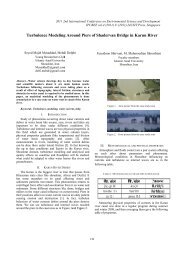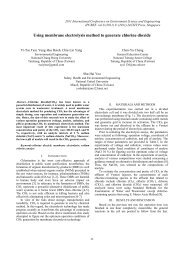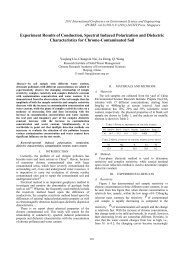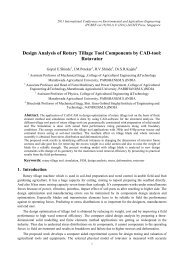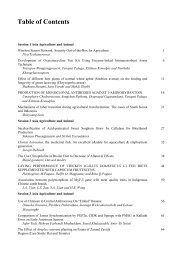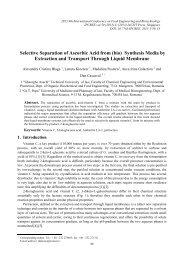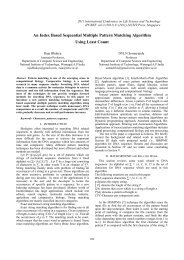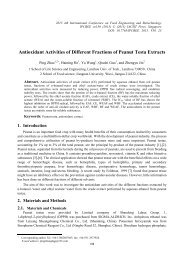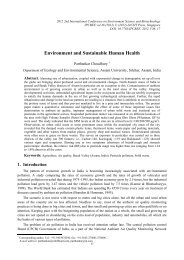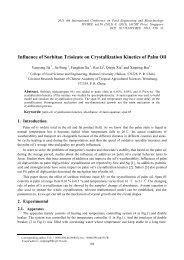Some Physical Properties of Parkia speciosa seeds - ipcbee
Some Physical Properties of Parkia speciosa seeds - ipcbee
Some Physical Properties of Parkia speciosa seeds - ipcbee
Create successful ePaper yourself
Turn your PDF publications into a flip-book with our unique Google optimized e-Paper software.
2011 International Conference on Food Engineering and Biotechnology<br />
IPCBEE vol.9 (2011) © (2011)IACSIT Press, Singapoore<br />
<strong>Some</strong> <strong>Physical</strong> <strong>Properties</strong> <strong>of</strong> <strong>Parkia</strong> <strong>speciosa</strong> <strong>seeds</strong><br />
M.H.R.O. Abdullah 1+ , P.E. Ch’ng 2 and T.H. Lim 3<br />
1 Department <strong>of</strong> Applied Sciences, Universiti Teknologi MARA (UiTM), 13500 Permatang Pauh, Pulau<br />
Pinang, Malaysia<br />
2 Department <strong>of</strong> Computer and Mathematical Sciences, Universiti Teknologi MARA (UiTM), 13500<br />
Permatang Pauh, Pulau Pinang, Malaysia<br />
3 Academy <strong>of</strong> Language Studies, Universiti Teknologi MARA (UiTM), 13500 Permatang Pauh, Pulau Pinang,<br />
Malaysia<br />
Abstract. <strong>Some</strong> physical properties <strong>of</strong> <strong>Parkia</strong> <strong>speciosa</strong> <strong>seeds</strong> were examined in this study. The average<br />
moisture content (wet basis) <strong>of</strong> the <strong>seeds</strong> was found to be 74.15 (±3.45) % while the mean moisture content<br />
(wet basis) <strong>of</strong> the pods was 73.02 (±0.43) %. The mean <strong>of</strong> length, width and thickness <strong>of</strong> the <strong>seeds</strong> was 23.20<br />
(±1.13), 17.27 (±0.99) and 9.87 (±0.82) mm respectively. The average value for geometric mean diameter,<br />
sphericity, aspect ratio, mass, surface area, volume, true density, bulk density and porosity was 15.80 (±0.85)<br />
mm, 68.15 (±2.52) %, 74.51 (±4.26) %, 1.868 (±0.316) g, 786.86 (±84.47) mm2, 2084.37 (±336.00) mm3,<br />
1089.46 (±73.40) kgm-3, 419.88 (±15.27) kgm-3 and 61.29 (±3.18) % respectively. The coefficient <strong>of</strong> static<br />
friction on four types <strong>of</strong> structural surface was found to be varying from 1.056 (±0.063) for plywood to 1.378<br />
(±0.110) for glass surface.<br />
Keywords: <strong>Parkia</strong> <strong>speciosa</strong>, physical properties, <strong>seeds</strong><br />
1. Introduction<br />
<strong>Parkia</strong> <strong>speciosa</strong> or popularly known as “petai” among the locals in Malaysia is a rainforest tree that can<br />
grow up to 40 m high and 100 cm in diameter. The tree is commonly found in Malaysia, Indonesia, Thailand<br />
and Philippines. It begins to bear fruit after about seven years <strong>of</strong> planting. The flowering and fruiting season<br />
<strong>of</strong> the tree peaks between August and October each year. The tree bears light-bulb shaped flowers that hang<br />
at the end <strong>of</strong> long stalks. Upon maturing, a cluster <strong>of</strong> long, twisted pods emerges at the end <strong>of</strong> each stalk. The<br />
<strong>Parkia</strong> <strong>speciosa</strong> <strong>seeds</strong> are encapsulated in these pods (Fig. 1). The <strong>seeds</strong> are very popular among the locals<br />
and are commonly used to prepare local traditional delicacy. They can be consumed raw or cooked with<br />
local spices such as garlic, chilli pepper and dried shrimp to enhance its aroma. The <strong>seeds</strong> are also used<br />
traditionally to treat diseases such as diabetes, kidney pain and cholera [1]. At present, the harvesting and<br />
processing <strong>of</strong> <strong>Parkia</strong> <strong>speciosa</strong> <strong>seeds</strong> in Malaysia are done manually. The operations are time consuming and<br />
labour intensive.<br />
In designing machine for handling, processing and storing <strong>of</strong> these <strong>seeds</strong>, physical properties such as<br />
mass, length, width, thickness, geometric mean diameter, surface area, volume, true density, bulk density,<br />
porosity, sphericity, aspect ratio and static friction on different types <strong>of</strong> surfaces are <strong>of</strong> paramount importance.<br />
In recent years, many researchers have reported physical and mechanical properties <strong>of</strong> various types <strong>of</strong> <strong>seeds</strong>.<br />
These include locust bean <strong>seeds</strong> [2], quinoa <strong>seeds</strong> [3], amaranth <strong>seeds</strong> [4], caper <strong>seeds</strong> [5], sweet corn <strong>seeds</strong><br />
[6], cucurbit <strong>seeds</strong> [7], jatropha <strong>seeds</strong> [8], roselle <strong>seeds</strong> [9], chia <strong>seeds</strong> [10], fennel <strong>seeds</strong> [11], arigo <strong>seeds</strong> [12]<br />
and nutmeg <strong>seeds</strong> [13]. The aim <strong>of</strong> this work was to determine some physical properties <strong>of</strong> <strong>Parkia</strong> <strong>speciosa</strong><br />
<strong>seeds</strong> which could be useful in facilitating the design <strong>of</strong> machines to handle, process and store the <strong>seeds</strong>.<br />
+ Corresponding author. Tel.: +6043823439; fax: +6043822768.<br />
E-mail address: harisridzuan@gmail.com.<br />
43
2. Materials and Methods<br />
Fig.1. Pods and <strong>seeds</strong> <strong>of</strong> <strong>Parkia</strong> <strong>speciosa</strong>.<br />
Fresh <strong>Parkia</strong> <strong>speciosa</strong> fruits were procured directly from a wet market in Bukit Mertajam town in the<br />
state <strong>of</strong> Penang, Malaysia. The fruits were processed manually to detach the <strong>seeds</strong> from their pods. Immature<br />
and broken <strong>seeds</strong> were removed from the sample. The physical properties <strong>of</strong> the <strong>seeds</strong> were determined at<br />
the temperature and relative humidity in the range <strong>of</strong> 21.2 – 25.1 o C and 70 – 90 % respectively for a period<br />
<strong>of</strong> not more than three days. During this period, the <strong>seeds</strong> were kept overnight in a refrigerator at 5 o C to<br />
maintain their freshness.<br />
Moisture content <strong>of</strong> the <strong>seeds</strong> and pods was determined using AOAC standard method [14]. Five<br />
samples <strong>of</strong> seed and five samples <strong>of</strong> pod were dried in an air ventilated oven at 80 o C for three days.<br />
Moisture content (wet basis) was calculated as:<br />
M i - M f<br />
MC (%) = × 100%<br />
(1)<br />
M i<br />
where MC (%) is the moisture content, M i is the initial mass and M f is the final mass <strong>of</strong> the seed.<br />
Three principal dimensions namely, length (L), width (W) and thickness (T) <strong>of</strong> 100 <strong>seeds</strong> were measured<br />
using a digital vernier calliper (Model CD-6BS-Mitutoyo Corporation, Japan) with a resolution <strong>of</strong> 0.01 mm.<br />
The measurements for each dimension were replicated 100 times.<br />
In order to calculate the geometric mean diameter (D) for each seed, the three principal dimensions were<br />
used. The geometric mean diameter was calculated based on the following equation [15]:<br />
1<br />
D = (LWT)<br />
3<br />
(2)<br />
Sphericity (S) is defined as the ratio <strong>of</strong> the surface area <strong>of</strong> a sphere having the same volume as the seed to<br />
the surface area <strong>of</strong> the seed. The sphericity was determined using the following expression [15]:<br />
1<br />
3<br />
( LWT )<br />
S = (3)<br />
L<br />
In order to gather more information about the shape <strong>of</strong> the seed, aspect ratio (R) <strong>of</strong> the seed was<br />
determined from the following relationship [16]:<br />
W<br />
R = ×100%<br />
(4)<br />
L<br />
The mass <strong>of</strong> 100 individual <strong>seeds</strong> was measured using an electronic balance (Model PS200/2000/C/2-<br />
RADWAG, Poland) with an accuracy <strong>of</strong> 0.001 g. The measurements were replicated 100 times.<br />
Surface area (A) <strong>of</strong> the seed was calculated based on the geometric mean diameter using the following<br />
formula [17]:<br />
2<br />
A = πD<br />
(5)<br />
44
Volume (V ) for 10 individual <strong>seeds</strong> was determined using water displacement method as described by<br />
Dutta et al. [18]. The <strong>seeds</strong> were weighed and coated with table glue and allowed to dry in order to prevent<br />
water absorption. Each seed was lowered into a measuring cylinder containing water such that the seed did<br />
not float during immersion in water. The weight <strong>of</strong> water displaced by the seed was recorded. The ratio <strong>of</strong><br />
mass to volume <strong>of</strong> the seed was treated as true density ( ρ ):<br />
ρ m<br />
T = V<br />
(6)<br />
where m = mass <strong>of</strong> individual seed (kg) and V = volume <strong>of</strong> individual seed (m 3 ).<br />
The bulk density is defined as the ratio <strong>of</strong> the mass <strong>of</strong> the sample <strong>of</strong> the <strong>seeds</strong> to its total volume. The<br />
bulk density was determined according to the method described by Fraser et al. [19] by filling an empty 250<br />
ml cylindrical container with <strong>Parkia</strong> <strong>speciosa</strong> <strong>seeds</strong>. The <strong>seeds</strong> were poured from a constant height, striking<br />
<strong>of</strong>f the top level and weighted. Bulk density ( ρ ) was calculated as<br />
m<br />
=<br />
B<br />
B<br />
ρ B<br />
(7)<br />
VB<br />
where m B = mass <strong>of</strong> the sample <strong>of</strong> <strong>seeds</strong> (kg) and V B = volume <strong>of</strong> container (m 3 ).<br />
Porosity (P) is described as the fraction <strong>of</strong> the space in the bulk grain that is not occupied by the grain.<br />
To calculate the porosity <strong>of</strong> the bulk seed, the following relationship [20] was used.<br />
ρ -<br />
P =<br />
ρ<br />
T p B<br />
T<br />
× 100%<br />
The coefficient <strong>of</strong> static friction was determined on four different structural surfaces, namely plywood,<br />
galvanized steel sheet, rubber and glass. Each seed was placed on the surface and raised gradually by screw<br />
until the seed begin to slide. The angle that the inclined surface makes with the horizontal when sliding<br />
begins was measured. The coefficient <strong>of</strong> static friction ( μ ) was calculated using the following expression:<br />
μs = tanθ<br />
(9)<br />
where θ = angle that the incline makes with the horizontal when sliding begins.<br />
3. Results and Discussion<br />
The results <strong>of</strong> some physical properties <strong>of</strong> <strong>Parkia</strong> <strong>speciosa</strong> <strong>seeds</strong> determined in this study were shown in<br />
Table 1. The moisture content (wet basis) <strong>of</strong> the <strong>seeds</strong> was found to be in the range <strong>of</strong> 68.59 – 77.70 % while<br />
the moisture content (wet basis) <strong>of</strong> the pods was in the range <strong>of</strong> 72.54 – 73.72 %. The moisture content is the<br />
most vital factor that influences the storability <strong>of</strong> the seed. The higher the moisture content, the shorter the<br />
storage life <strong>of</strong> the seed would be due to the rapid growth <strong>of</strong> mould on the seed. Table 1 shows that the <strong>Parkia</strong><br />
<strong>speciosa</strong> seed has mean moisture content <strong>of</strong> 74.15%. This would suggest that the seed has poor storage<br />
potential due to its high moisture content. The mean value <strong>of</strong> length, width and thickness <strong>of</strong> the <strong>seeds</strong> was<br />
23.20 (±1.13), 17.27 (±0.99) and 9.87 (±0.82) mm respectively. The dimensions <strong>of</strong> <strong>Parkia</strong> <strong>speciosa</strong> <strong>seeds</strong><br />
were higher than those for cucurbit <strong>seeds</strong> [7] and jatropha <strong>seeds</strong> [8] but lower than fennel <strong>seeds</strong> [11].<br />
Dimensions <strong>of</strong> the seed are <strong>of</strong> paramount importance in determining the aperture size <strong>of</strong> the machine to<br />
process the seed. Apart from that, the dimensions could be useful in determining the shape <strong>of</strong> the seed. Since<br />
the three semi-axes <strong>of</strong> the seed are unequal, the shape <strong>of</strong> <strong>Parkia</strong> <strong>speciosa</strong> seed is considered as scalene<br />
ellipsoid. The calculated geometric mean diameter ranges from 13.19 to 18.10 mm with a mean value <strong>of</strong><br />
15.80 (±0.85) mm. The geometric mean diameter obtained can be used to determine the volume and<br />
sphericity <strong>of</strong> the seed theoretically.<br />
The mean <strong>of</strong> sphericity and aspect ratio <strong>of</strong> the <strong>seeds</strong> were 68.15 (±2.52) % and 74.51 (±4.26) %<br />
respectively while the mean mass <strong>of</strong> the <strong>seeds</strong> was 1.868 (±0.316) g. The sphericity was higher compared to<br />
fennel <strong>seeds</strong> [11] but lower than amaranth [4] and caper <strong>seeds</strong> [5]. The low sphericity and aspect ratio <strong>of</strong> the<br />
<strong>seeds</strong> indicate that the <strong>Parkia</strong> <strong>speciosa</strong> seed is likely to slide on their flat surfaces rather than roll. This<br />
parameter is <strong>of</strong> utmost importance in designing <strong>of</strong> hopper to handle the <strong>seeds</strong>. The average surface area was<br />
found to be 786.86 (±84.47) mm 2 while the mean volume determined for 10 <strong>seeds</strong> was 2084.37 (±336.00)<br />
mm 3 . True density and bulk density <strong>of</strong> the <strong>seeds</strong> were 1089.46 (±73.40) and 419.88 (±15.27) kgm -3<br />
respectively. The reported value <strong>of</strong> true density for quinoa [3] and arigo [12] <strong>seeds</strong> are very similar to <strong>Parkia</strong><br />
45<br />
T<br />
s<br />
(8)
<strong>speciosa</strong> seed. However, their bulk density was higher compared to <strong>Parkia</strong> <strong>speciosa</strong> seed. The bigger size <strong>of</strong><br />
<strong>Parkia</strong> <strong>speciosa</strong> <strong>seeds</strong> may have contributed to the lower value <strong>of</strong> bulk density. This parameter is important<br />
in determining the storage capacity. The average porosity <strong>of</strong> the <strong>Parkia</strong> <strong>speciosa</strong> <strong>seeds</strong> was 61.29 (±3.18) %.<br />
This value was found to be in the same order as sweet corn [6] and fennel <strong>seeds</strong> [11] but higher than locust<br />
bean [2] and chia <strong>seeds</strong> [10]. The porosity <strong>of</strong> seed is important because it shows the resistance <strong>of</strong> the <strong>seeds</strong> to<br />
airflow during drying process.<br />
The coefficient <strong>of</strong> static friction <strong>of</strong> <strong>Parkia</strong> <strong>speciosa</strong> <strong>seeds</strong> against four types <strong>of</strong> structural surface was<br />
determined. The results were indicated in Table 2. The coefficient <strong>of</strong> static friction for <strong>Parkia</strong> <strong>speciosa</strong> <strong>seeds</strong><br />
were greater than the values reported for cucurbit <strong>seeds</strong> [7] and nutmeg <strong>seeds</strong> [13]. The large value <strong>of</strong><br />
coefficient <strong>of</strong> static friction may be attributed to the high moisture content in the seed as well as the<br />
stickiness <strong>of</strong> the surface <strong>of</strong> the seed. It was found that the seed had the highest coefficient <strong>of</strong> static friction on<br />
glass followed by galvanized steel sheet, rubber and plywood. This property is <strong>of</strong> paramount importance in<br />
determining the steepness <strong>of</strong> the storage container, hopper or any other loading and unloading device [12].<br />
Table 1. <strong>Some</strong> physical properties <strong>of</strong> <strong>Parkia</strong> <strong>speciosa</strong> <strong>seeds</strong>.<br />
<strong>Physical</strong> properties Unit <strong>of</strong><br />
measurement<br />
No. <strong>of</strong><br />
observation<br />
Mean<br />
value<br />
Minimum<br />
value<br />
Maximum<br />
value<br />
Standard<br />
deviation<br />
Moisture content <strong>of</strong> % 5 74.15 68.59 77.70 3.45<br />
seed (w.b.)<br />
Moisture content <strong>of</strong> % 5 73.02 72.54 73.72 0.43<br />
pod (w.b.)<br />
Length mm 100 23.20 18.52 25.64 1.13<br />
Width mm 100 17.27 14.15 20.23 0.99<br />
Thickness mm 100 9.87 8.08 12.38 0.82<br />
Geometric mean mm 100 15.80 13.19 18.10 0.85<br />
diameter (GMD)<br />
Sphericity % 100 68.15 63.27 75.61 2.52<br />
Aspect ratio % 100 74.51 65.05 84.72 4.26<br />
Mass g 100 1.868 1.139 2.906 0.316<br />
Surface area mm 2 100 786.86 546.44 1028.71 84.47<br />
Volume mm 3 10 2084.37 1201.14 3102.51 336.00<br />
True density kg m -3 10 1089.46 929.23 1212.00 73.40<br />
Bulk density kg m -3 10 419.88 403.20 457.28 15.27<br />
Porosity % 10 61.29 54.67 66.11 3.18<br />
Table 2. Coefficient <strong>of</strong> static friction <strong>of</strong> <strong>Parkia</strong> <strong>speciosa</strong> <strong>seeds</strong> on four types <strong>of</strong> structural surface.<br />
Coefficient <strong>of</strong> static<br />
friction on<br />
No. <strong>of</strong><br />
observation<br />
Mean value Minimum<br />
value<br />
Maximum<br />
value<br />
Standard<br />
deviation<br />
Plywood 25 1.056 0.933 1.150 0.063<br />
Galvanized steel sheet 25 1.270 1.036 1.483 0.114<br />
Rubber 25 1.183 0.966 1.376 0.100<br />
Glass 25 1.378 1.192 1.540 0.110<br />
4. Conclusion<br />
The average moisture content (wet basis) <strong>of</strong> the <strong>Parkia</strong> <strong>speciosa</strong> <strong>seeds</strong> determined in this study was<br />
74.15 (±3.45) % while the mean moisture content (wet basis) <strong>of</strong> the pods was 73.02 (±0.43) %. The mean <strong>of</strong><br />
length, width and thickness <strong>of</strong> the <strong>seeds</strong> was 23.20 (±1.13), 17.27 (±0.99) and 9.87 (±0.82) mm respectively.<br />
The average value for geometric mean diameter, sphericity, aspect ratio, mass, surface area, volume, true<br />
density, bulk density and porosity was 15.80 (±0.85) mm, 68.15 (±2.52) %, 74.51 (±4.26) %, 1.868 (±0.316)<br />
g, 786.86 (±84.47) mm 2 , 2084.37 (±336.00) mm 3 , 1089.46 (±73.40) kgm -3 , 419.88 (±15.27) kgm -3 and 61.29<br />
(±3.18) % respectively. The coefficient <strong>of</strong> static friction on four types <strong>of</strong> structural surface was found to be<br />
46
vary from 1.056 (±0.063) for plywood to 1.378 (±0.110) for glass surface. The technical data obtained in this<br />
study may be useful in the design <strong>of</strong> machine for handling and processing <strong>of</strong> the <strong>Parkia</strong> <strong>speciosa</strong> <strong>seeds</strong>.<br />
5. References<br />
[1] C. Orwa, A. Mutua, R. Kindt, R. Jamnadass and A. Simons. Agr<strong>of</strong>orestree Database: a tree reference and<br />
selection guide version 4.0. 2009. (http://www.worldagr<strong>of</strong>orestry.org/af/treedb/) (accessed 23.12.2010)<br />
[2] L.A.O. Ogunjimi, N.A. Aviara and O.A. Aregbesola. <strong>Some</strong> physical engineering properties <strong>of</strong> locust bean seed. J.<br />
Food Eng. 2002, 55: 95-99.<br />
[3] C. Vilche, M. Gely, and E. Santalla. <strong>Physical</strong> properties <strong>of</strong> quinoa <strong>seeds</strong>. Biosyst. Eng. 2003, 86: 59–65.<br />
[4] R. Abalone, A. Cassinera, A. Gast´on, and M.A. Lara. <strong>Some</strong> physical properties <strong>of</strong> Amaranth <strong>seeds</strong>. Biosyst. Eng.<br />
2004, 89: 109–117.<br />
[5] E. Dursun and I. Dursun. <strong>Some</strong> physical properties <strong>of</strong> caper seed. Biosyst. Eng. 2005, 92: 237-245.<br />
[6] M. Bulent Coskun, I. Yalcin and C. Ozarslan. <strong>Physical</strong> properties <strong>of</strong> sweet corn seed (Zea mays saccharata Sturt.).<br />
Journal <strong>of</strong> Food Engineering. 2006, 74 (4): 523–528.<br />
[7] E. Milani, S.M.A. Razavi, A. Koocheki, V. Nikzadeh, N. Vahedi, M. MoeinFord and A. GholamhosseinPour.<br />
Moisture dependent physical properties <strong>of</strong> cucurbit <strong>seeds</strong>. Int. Agrophysics. 2007, 21: 157-168.<br />
[8] D.K. Garnayak, R.C. Pradhan, S.N. Nalk and N. Bhatnagar. Moisture-dependent physical properties <strong>of</strong> jatropha<br />
seed. Industrial Crops Products. 2008, 27: 127-129.<br />
[9] J. Sánchez-Mendoza, A. Domínguez, S. Navarro-Galindo and J.A. Lüpez-Sandova. <strong>Some</strong> physical properties <strong>of</strong><br />
roselle (Hibiscus Sabdariffa L.) <strong>seeds</strong> as a function <strong>of</strong> moisture content. J. Food Eng. 2008, 87: 391-397.<br />
[10] V.Y. Ixtaina, S.M. Nolasco and M.C. Tomas. <strong>Physical</strong> properties <strong>of</strong> chia (Salvia hispanica L.) <strong>seeds</strong>. Industrial<br />
Crops Products. 2008, 28: 286-293.<br />
[11] H. Ahmadi and K. Mollazade. <strong>Some</strong> physical and mechanical properties <strong>of</strong> fennel seed (Foeniculum vulgare). J.<br />
Agric. Sci. 2009, 1(1): 66-75.<br />
[12] R.M. Davies. <strong>Some</strong> physical properties <strong>of</strong> Arigo <strong>seeds</strong>. Int. Agrophys. 2010, 24: 89-92.<br />
[13] M.H.R.O. Abdullah, P.E. Ch’ng and T.H. Lim. Determination <strong>of</strong> <strong>Some</strong> <strong>Physical</strong> <strong>Properties</strong> <strong>of</strong> Nutmeg (Myristica<br />
fragrans) Seeds. Research Journal <strong>of</strong> Applied Sciences, Engineering and Technology. 2010, 2(7): 669-672.<br />
[14] AOAC. Official Methods <strong>of</strong> Analysis. Association <strong>of</strong> Official Analytical Chemists, Washington, DC., 1984.<br />
[15] N.N. Mohsenin. <strong>Physical</strong> <strong>Properties</strong> <strong>of</strong> Plant and Animal Materials. Gordon and Breach Science Publishers, New<br />
York, USA., 1970.<br />
[16] J.N. Maduako and M.O. Faborode, <strong>Some</strong> physical properties <strong>of</strong> cocoa pods in relation to primary processing. Ife J.<br />
Technol. 1990, 2: 1-7.<br />
[17] W.L. McCabe, J.C. Smith and P. Harriot. Unit Operations <strong>of</strong> Chemical Engineering. McGraw-Hill Press, New<br />
York, USA., 1986.<br />
[18] S.K. Dutta, V.K. Nema and R.K. Bhardway. <strong>Physical</strong> properties <strong>of</strong> gram. Journal <strong>of</strong> Agricultural Engineering<br />
Research. 1988, 39: 259–268.<br />
[19] B.M. Fraser, S.S. Verma and W.E. Muir. <strong>Some</strong> physical properties <strong>of</strong> fanabeans. Journal <strong>of</strong> Agricultural<br />
Engineering Research. 1978, 22: 53–57.<br />
[20] R. Thompson and W. Isaac. Porosity determination <strong>of</strong> grains and <strong>seeds</strong> with air comparison pycnometer.<br />
Transactions <strong>of</strong> the ASAE. 1967, 10(5): 693-696.<br />
47





